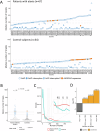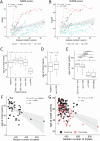Identification and characterisation of pathogenic and non-pathogenic FGF14 repeat expansions
- PMID: 39227614
- PMCID: PMC11372089
- DOI: 10.1038/s41467-024-52148-1
Identification and characterisation of pathogenic and non-pathogenic FGF14 repeat expansions
Abstract
Repeat expansions in FGF14 cause autosomal dominant late-onset cerebellar ataxia (SCA27B) with estimated pathogenic thresholds of 250 (incomplete penetrance) and 300 AAG repeats (full penetrance), but the sequence of pathogenic and non-pathogenic expansions remains unexplored. Here, we demonstrate that STRling and ExpansionHunter accurately detect FGF14 expansions from short-read genome data using outlier approaches. By combining long-range PCR and nanopore sequencing in 169 patients with cerebellar ataxia and 802 controls, we compare FGF14 expansion alleles, including interruptions and flanking regions. Uninterrupted AAG expansions are significantly enriched in patients with ataxia from a lower threshold (180-200 repeats) than previously reported based on expansion size alone. Conversely, AAGGAG hexameric expansions are equally frequent in patients and controls. Distinct 5' flanking regions, interruptions and pre-repeat sequences correlate with repeat size. Furthermore, pure AAG (pathogenic) and AAGGAG (non-pathogenic) repeats form different secondary structures. Regardless of expansion size, SCA27B is a recognizable clinical entity characterized by frequent episodic ataxia and downbeat nystagmus, similar to the presentation observed in a family with a previously unreported nonsense variant (SCA27A). Overall, this study suggests that SCA27B is a major overlooked cause of adult-onset ataxia, accounting for 23-31% of unsolved patients. We strongly recommend re-evaluating pathogenic thresholds and integrating expansion sequencing into the molecular diagnostic process.
© 2024. The Author(s).
Conflict of interest statement
MS received consultancy honoraria from Solaxa. All other authors report no competing interests.
Figures







References
Publication types
MeSH terms
Substances
LinkOut - more resources
Full Text Sources
Molecular Biology Databases

